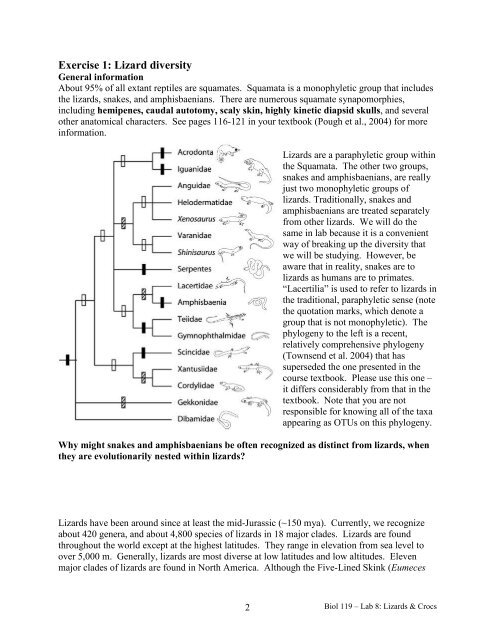Biol 119 – Herpetology Lab 8: Lizard and ... - Clark University
Biol 119 – Herpetology Lab 8: Lizard and ... - Clark University
Biol 119 – Herpetology Lab 8: Lizard and ... - Clark University
Create successful ePaper yourself
Turn your PDF publications into a flip-book with our unique Google optimized e-Paper software.
Exercise 1: <strong>Lizard</strong> diversity<br />
General information<br />
About 95% of all extant reptiles are squamates. Squamata is a monophyletic group that includes<br />
the lizards, snakes, <strong>and</strong> amphisbaenians. There are numerous squamate synapomorphies,<br />
including hemipenes, caudal autotomy, scaly skin, highly kinetic diapsid skulls, <strong>and</strong> several<br />
other anatomical characters. See pages 116-121 in your textbook (Pough et al., 2004) for more<br />
information.<br />
<strong>Lizard</strong>s are a paraphyletic group within<br />
the Squamata. The other two groups,<br />
snakes <strong>and</strong> amphisbaenians, are really<br />
just two monophyletic groups of<br />
lizards. Traditionally, snakes <strong>and</strong><br />
amphisbaenians are treated separately<br />
from other lizards. We will do the<br />
same in lab because it is a convenient<br />
way of breaking up the diversity that<br />
we will be studying. However, be<br />
aware that in reality, snakes are to<br />
lizards as humans are to primates.<br />
“Lacertilia” is used to refer to lizards in<br />
the traditional, paraphyletic sense (note<br />
the quotation marks, which denote a<br />
group that is not monophyletic). The<br />
phylogeny to the left is a recent,<br />
relatively comprehensive phylogeny<br />
(Townsend et al. 2004) that has<br />
superseded the one presented in the<br />
course textbook. Please use this one <strong>–</strong><br />
it differs considerably from that in the<br />
textbook. Note that you are not<br />
responsible for knowing all of the taxa<br />
appearing as OTUs on this phylogeny.<br />
Why might snakes <strong>and</strong> amphisbaenians be often recognized as distinct from lizards, when<br />
they are evolutionarily nested within lizards?<br />
<strong>Lizard</strong>s have been around since at least the mid-Jurassic (~150 mya). Currently, we recognize<br />
about 420 genera, <strong>and</strong> about 4,800 species of lizards in 18 major clades. <strong>Lizard</strong>s are found<br />
throughout the world except at the highest latitudes. They range in elevation from sea level to<br />
over 5,000 m. Generally, lizards are most diverse at low latitudes <strong>and</strong> low altitudes. Eleven<br />
major clades of lizards are found in North America. Although the Five-Lined Skink (Eumeces<br />
2<br />
<strong>Biol</strong> <strong>119</strong> <strong>–</strong> <strong>Lab</strong> 8: <strong>Lizard</strong>s & Crocs
















